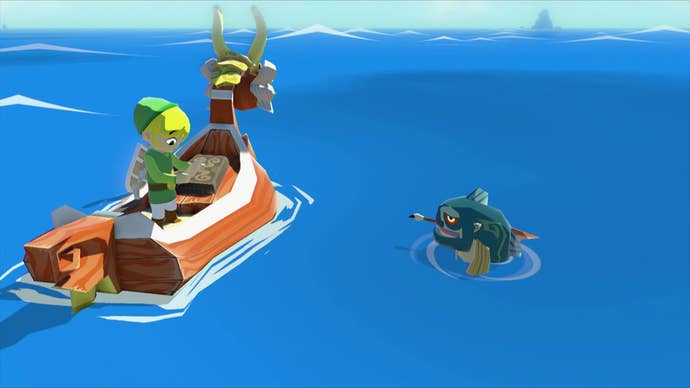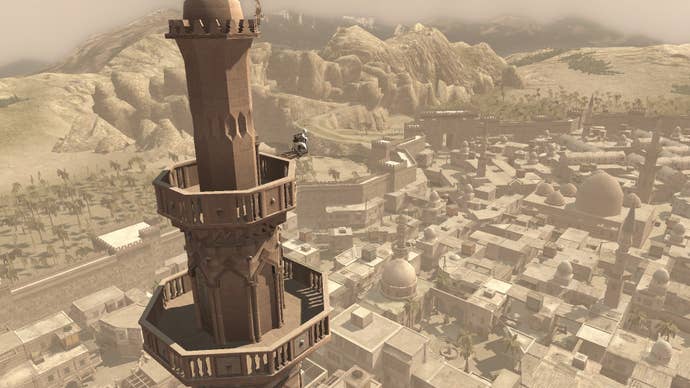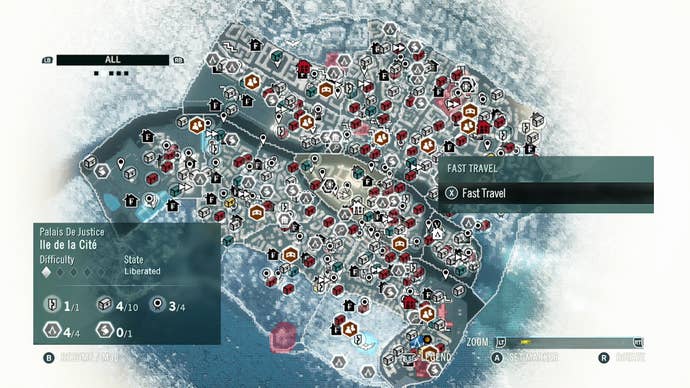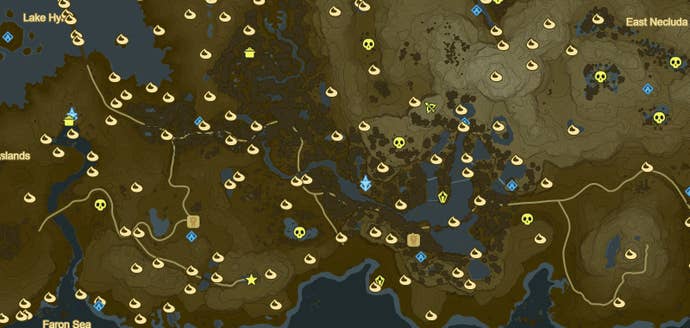Exploring and Uncovering the Dreaded Ubisoft Tower
Mike looks back at one of the open-world mechanics that feels like its everywhere these days.
This article first appeared on USgamer, a partner publication of VG247. Some content, such as this article, has been migrated to VG247 for posterity after USgamer's closure - but it has not been edited or further vetted by the VG247 team.
Hidden in my review of The Legend of Zelda: Breath of the Wild were two words that gave a bunch of folks pause: "Ubisoft towers". Just mentioning them caused some folks to stop in their tracks and rethink their Zelda-playing future. Why does this one mechanic cause people to freeze up in fear?

Let's first define what has become colloquially known as the "Ubisoft Tower". In open-world games, players are offered a large space to explore and play in, but the pace of discovery is managed by the developer. Developers can offer a boundless world with no guidelines like Minecraft, but some want to straddle both lines, offering exploration, but providing certain funnels towards the intended experience.
One way to focus that player experience is to parcel the game world out into distinct, playable chunks. The player's map is covered in a fog of war and subdivided regions, essentially acting as defacto levels. This isn't the only way to go, as there were and are open-world titles without a mini-map or non-diegetic (something that does not exist in the game world) map screen, like Shenmue and its sequel.
You could have the player clear the fog of war manually by walking over every square-inch of the map, but that's rather time-consuming and tedious. At that point, it's almost better to return to completely open-ended exploration. So instead, a developer introduces a challenge mechanic, which when completed, will clear the fog and show you layout of the current area. In The Legend of Zelda: Wind Waker, you reveal regions of the map by hunting for Fishmen and feeding them bait. Opening up these areas on an in-game map allows the player to feel like they're working towards something tangible. (Some players need carrots.)
Open-world games aren't new, but the technological power to build complex and detailed worlds is, and as fidelity trends upwards you need ways to let players know where they can go and what they can interact with. (The latter issue gave rise to Detective Vision, another prevalent mechanic in recent games.)

Given a naturally-styled and high-fidelity open-world, you want points-of-interest to stand out to a player. Continuing the Wind Waker example above, the Fishmen make themselves known by leaping up out of the water; given the vast blue ocean, this movement stands out. Developers are also known to offer direct waypoints and breadcrumbs to a specific structure, in-game highlights via a marker, or an alternate vision mechanic (Detective Vision strikes again). Back in 2007, Ubisoft decided to go with one simple way to solve that problem in its open-world.
Ubisoft's Assassin's Creed was the first title to really offer what would become a staple of the entire publisher. In that game, Ubisoft differentiated your map view points by making them the tallest structures in any region. In the relatively flat cities of the first game, these focal points would draw the player's eye simply by standing above everything else. Given Assassin's Creed's early focus on climbing, seeing a tower offered a natural challenge to a player: "See if you can scale me."
Once you had figured out how to crawl to the top of the tower, you were not only rewarded with a view of the city below, but you also uncovered specific missions within that region of the city. The point was to funnel the player back towards the core game experience: the assassinations.
That's different from something like Far Cry 2, which has a simple in-game map and open exploration, because the focus there is the player surviving against the environment. In the first Assassin's Creed, the open world was a detailed backdrop for the primary conflict; it was built for immersion, not so every part would be an hotspot for useful and engaging play.

The Ubisoft Tower is an expansion on this point. In Assassin's Creed, it's always a series of towers and high vantage points that need to be climbed. This extended into Far Cry 3 and 4, which had Radio and Bell Towers respectively. In Watch Dogs, the ctOS towers didn't necessarily have to be climbed; the challenge was in figuring how to gain access to the server itself. On the back of those three franchises, which released a total of 15 titles since 2007's launch of Assassin's Creed, that the idea of the "Ubisoft Tower" came to be.
To be clear, it's not only Ubisoft's own games that use the tower mechanic. Middle-Earth: Shadow of Mordor has actual towers and enemy bases, Batman: Arkham Knight has watchtowers and checkpoints, Infamous: Second Son has D.U.P bases and towers, Mad Max has towers you have to pull down, and Dying Light has antenna towers. That's only a few of the open-world games that use towers and other structures to open the map for players.
The issue is that while the mechanic is mostly sound, there's a large amount of growth in the number of additional things you do in an open-world game. While Assassin's Creed began with just the assassination missions and feathers, later games have added more things to do and more stuff to collect.

In Assassin's Creed Syndicate, which is slightly better than the infamous AC Unity about how it handles its map, there are primary missions, a host of region conquest activities, London Stories, map viewpoints, fight clubs, beer bottles, illustrations, pressed flowers, royal letters, and randomly-generated Cargo hijacks. Whereas having a fully-open map in earlier open-world games like Elder Scrolls: Oblivion caused people to become dizzy over the sheer scope of the world, now the issue is the sheer amount of minutiae to deal with. (I tend to just turn the icon filters off.)
The Legend of Zelda: Breath of the Wild undeniably has Ubisoft towers, which you climb in order to reveal huge chunks of the map. It's full of a ton of things to find and collect. The difference is in the presentation. In Breath of the Wild, nothing is given to you other than the topographical layout of a region. You scale a tower and look down on high to find physical points of interest that speak to you, and then place your own pins and stamps on the map. It's map-making, which speaks to the wanderlust of certain folks.
I don't particularly have a problem with the Ubisoft Tower, but I understand why others do. I get why people are enjoying that aspect of Breath of the Wild or cheering the lack of towers in Ubisoft's own Watch Dogs 2. It's not a bad mechanic, but it's also not a mechanic that works for every open-world game out there. Part of game design is finding the mechanics that bring out the best in your game. Sometimes I feel that developers may forget that, and instead just take the easy way forward and that does a disservice to their game.


